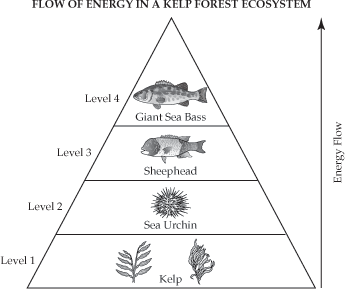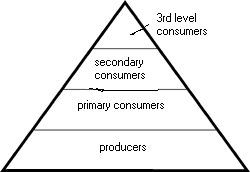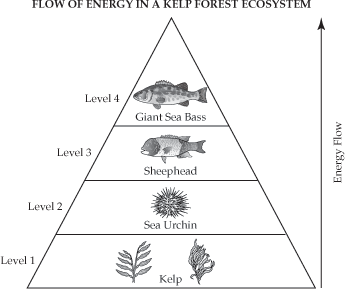AP EcoSystem (54) Quiz

Explore the dynamics of energy transfer within ecosystems, focusing on energy pyramids, trophic levels, and the role of organisms in energy flow.
- 1.
Look at the following energy pyramid. If the producers have 7000 kcal of energy, how much energy will be available for the Sheephead ?fish?
- A.
7 kcal
- B.
70 kcal
- C.
700 kcal
- D.
7000 kcal
Correct Answer
B. 70 kcalExplanation
The energy pyramid shows the flow of energy in an ecosystem, with producers at the bottom and consumers at higher levels. As energy moves up the pyramid, it decreases because energy is lost as heat or used for metabolic processes. In this case, if the producers have 7000 kcal of energy, the energy available for the Sheephead fish would be less than that. The correct answer of 70 kcal suggests that only 1% of the energy from the producers is available for the Sheephead fish.Rate this question:
-
- 2.
Which level of this food pyramid represents the largest amount of organisms?
- A.
Tertiary consumers
- B.
Secondary consumers
- C.
Primary consumers
- D.
Producers
Correct Answer
D. ProducersExplanation
Producers represent the largest amount of organisms in the food pyramid. Producers, such as plants and algae, are able to convert sunlight into energy through photosynthesis. They form the base of the food pyramid and provide food and energy for all other organisms. As a result, there are generally more producers than any other level in the food pyramid.Rate this question:
-
- 3.
Which of these best describes the relationship shown by this Kelp Forest Ecosystempyramid?
- A.
The Giant Sea Bass is a predator of the Sheephead
- B.
The Giant Sea Bass is the prey of the Sheephead
- C.
Sea Urchins are the prey of the Kelp.
- D.
Sheepheads are the predator of the Giant Sea Bass
Correct Answer
A. The Giant Sea Bass is a predator of the SheepheadExplanation
The correct answer is "The Giant Sea Bass is a predator of the Sheephead". This relationship is indicated by the direction of the arrow in the pyramid, showing that the Giant Sea Bass consumes the Sheephead. In a predator-prey relationship, one organism (the predator) hunts and consumes another organism (the prey) for food.Rate this question:
-
- 4.
If birds eat insects that feed on corn, which pyramid level would birds occupy?
- A.
A
- B.
B
- C.
C
- D.
D
Correct Answer
B. BExplanation
Birds would occupy pyramid level B. This is because birds are secondary consumers, meaning they eat primary consumers, which in this case would be the insects that feed on corn. Pyramid level B represents the secondary consumers in the food chain.Rate this question:
-
- 5.
An energy pyramid is used to show _________.
- A.
The layout of organisms in any order seen fit
- B.
The amount of energy in the universe
- C.
The amount of energy at each trophic level
- D.
Organized by organism size
Correct Answer
C. The amount of energy at each trophic levelExplanation
An energy pyramid is a graphical representation that illustrates the flow of energy through different trophic levels in an ecosystem. It shows the amount of energy available at each level, with the primary producers (such as plants) at the bottom and the top predators at the top. As energy is transferred from one level to another, it decreases, resulting in a pyramid shape. Therefore, the correct answer is "the amount of energy at each trophic level."Rate this question:
-
- 6.
Net primary productivity represents
- A.
The amount of biomass in excess of that needed to support plant cell respiration.
- B.
The rate at which energy is captured during photosynthesis.
- C.
The amount of carbon dioxide produced by plants.
- D.
Energy production in an area per unit time.
- E.
Plant reproduction per unit area per unit time.
Correct Answer
A. The amount of biomass in excess of that needed to support plant cell respiration.Explanation
Net primary productivity represents the amount of biomass that is produced by plants through photosynthesis, minus the amount of biomass that is used by plants for their own respiration. It is the measure of the energy that is available for consumption by herbivores and higher trophic levels in an ecosystem. This measure is important as it indicates the productivity and efficiency of an ecosystem in converting solar energy into plant biomass. The correct answer, "the amount of biomass in excess of that needed to support plant cell respiration," accurately describes the concept of net primary productivity.Rate this question:
-
- 7.
Primary source of carbon for photosynthetic organisms is:
- A.
Bicarbonate in the water.
- B.
Nitrate in the soil.
- C.
Carbon dioxide in the atmosphere and water.
- D.
Dissolved phosphate in water.
- E.
Carbonic acid in rain.
Correct Answer
C. Carbon dioxide in the atmosphere and water.Explanation
Photosynthetic organisms, such as plants and algae, use carbon dioxide (CO2) from the atmosphere and dissolved in water as their primary source of carbon. During photosynthesis, they convert CO2 into glucose and other organic compounds, using sunlight as an energy source. Bicarbonate in the water, nitrate in the soil, dissolved phosphate in water, and carbonic acid in rain are not the primary sources of carbon for photosynthetic organisms.Rate this question:
-
- 8.
Which of the following terms is synonymous with photosynthetic organisms?
- A.
Primary consumer and autotroph
- B.
Primary producer and autotroph
- C.
Primary producer and heterotroph
- D.
Primary consumer and heterotroph
- E.
Primary consumer and producer
Correct Answer
B. Primary producer and autotrophExplanation
Photosynthetic organisms are capable of producing their own food through the process of photosynthesis. They convert sunlight, water, and carbon dioxide into glucose and oxygen. Primary producers are organisms that can produce their own food, and autotrophs are organisms that can create organic compounds from inorganic substances. Therefore, the term "primary producer and autotroph" is synonymous with photosynthetic organisms.Rate this question:
-
- 9.
Which of the following statements reflects a key concept about ecosystems?
- A.
Matter moves linearly through different systems, both abiotic and biotic, within an ecosystem
- B.
There is a one-way flow of energy through the food webs of ecosystems
- C.
Conservation should focus on the success and survival of individual species
- D.
The abiotic environment does not influence the distribution and survival of particular organisms.
Correct Answer
B. There is a one-way flow of energy through the food webs of ecosystemsExplanation
The statement "There is a one-way flow of energy through the food webs of ecosystems" reflects a key concept about ecosystems. This concept refers to how energy is transferred from one organism to another in a linear manner within an ecosystem. Energy flows from producers (plants) to consumers (animals), and it is not recycled back to the producers. This one-way flow of energy is essential for the functioning and stability of ecosystems.Rate this question:
-
- 10.
What key factor limits the number of trophic levels in an ecosystem?
- A.
Maximum solar radiation
- B.
Energy loss
- C.
Herbivore size
- D.
Predator size
- E.
Climate
Correct Answer
B. Energy lossExplanation
The key factor that limits the number of trophic levels in an ecosystem is energy loss. As energy moves through the food chain, it is transferred from one organism to another, but not all of it is absorbed and utilized. Each transfer of energy results in a loss of energy, often in the form of heat. This energy loss limits the amount of energy available to support higher trophic levels, as there is not enough energy left to sustain a large number of organisms at the top of the food chain.Rate this question:
-
- 11.
Fixation of carbon is accomplished by:
- A.
Photosynthetic organisms.
- B.
Primary consumers
- C.
Decomposers.
- D.
Bacterial decomposers.
- E.
Burning of organic matter.
Correct Answer
A. Photosynthetic organisms.Explanation
Photosynthetic organisms, such as plants and algae, are capable of fixing carbon through the process of photosynthesis. During photosynthesis, these organisms use sunlight, water, and carbon dioxide to produce glucose and oxygen. The carbon dioxide is converted into organic compounds, effectively fixing carbon from the atmosphere. This process is crucial for the carbon cycle and plays a vital role in maintaining the balance of carbon dioxide in the atmosphere. Primary consumers, decomposers, bacterial decomposers, and the burning of organic matter are not directly involved in the process of carbon fixation.Rate this question:
-
- 12.
The major atmospheric components of Earth, from the lowest concentration to the greatest concentration, are:
- A.
Nitrogen, carbon dioxide, and oxygen.
- B.
Nitrogen, oxygen, and carbon dioxide.
- C.
Carbon dioxide, nitrogen, and oxygen.
- D.
Carbon dioxide, oxygen, and nitrogen.
- E.
Oxygen, nitrogen, and carbon dioxide.
Correct Answer
D. Carbon dioxide, oxygen, and nitrogen.Explanation
The major atmospheric components of Earth are carbon dioxide, oxygen, and nitrogen. This is because nitrogen makes up the largest portion of Earth's atmosphere, followed by oxygen, and then carbon dioxide.Rate this question:
-
- 13.
The causes of increased carbon dioxide being released into the atmosphere include:
- A.
The burning of fossil fuels such as coal and gasoline.
- B.
The burning of wood.
- C.
Cattle production.
- D.
Heating with natural gas.
- E.
All of these.
Correct Answer
E. All of these.Explanation
The correct answer is "All of these" because all the mentioned activities contribute to the release of carbon dioxide into the atmosphere. Burning fossil fuels like coal and gasoline, burning wood, cattle production, and heating with natural gas all release carbon dioxide as a byproduct. Therefore, all of these activities are responsible for the increased release of carbon dioxide into the atmosphere.Rate this question:
-
- 14.
Fixation of nitrogren is usually accomplished by
- A.
Corn
- B.
Algae
- C.
Bacteria
- D.
Lichens
- E.
Photosynthetic producers
Correct Answer
C. BacteriaExplanation
Nitrogen fixation is the process of converting atmospheric nitrogen into a usable form by living organisms. While corn, algae, lichens, and photosynthetic producers play important roles in ecosystems, they do not have the ability to fix nitrogen. Bacteria, specifically nitrogen-fixing bacteria, have the capability to convert atmospheric nitrogen into ammonia, which can then be used by other organisms. Therefore, bacteria are the correct answer for the process of nitrogen fixation.Rate this question:
-
- 15.
The total amount of organic food produced in an ecosystem is measured by
- A.
Primary productivity
- B.
Gross primary productivity
- C.
Net primary productivity
- D.
Food web
- E.
Nitrogen cycle
Correct Answer
B. Gross primary productivityExplanation
Gross primary productivity refers to the total amount of organic matter produced by plants through photosynthesis in an ecosystem. It represents the energy available for consumption by other organisms in the food chain. This measurement includes all the organic matter produced, regardless of whether it is used by the plants for their own growth or consumed by herbivores. It provides an estimate of the overall productivity and energy flow within the ecosystem.Rate this question:
-
Quiz Review Timeline +
Our quizzes are rigorously reviewed, monitored and continuously updated by our expert board to maintain accuracy, relevance, and timeliness.
-
Current Version
-
Mar 20, 2023Quiz Edited by
ProProfs Editorial Team -
Sep 12, 2014Quiz Created by
Justin Lovrien





